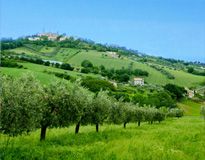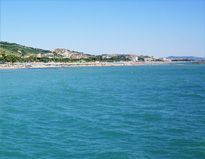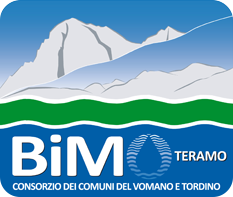
Teramo station
Its construction goes up at the end of 1800 and today the building still preserves the characteristics having been restructured in the full respect of the laws of the architectural style typical of the period. The station is the end of the railway line Teramo-Giulianova. From the station of Teramo, crossing Francesco Crispi avenue and going beyond San Ferdinando Bridge, you reach the famous Noce source, a splendid example of medieval architecture that was used to furnish drinkable water to the city. In the area are also found one of the four doors of Teramo, Porta Reale, honorary access to the city, built for the visit of Federico I Borbone. Continuing on Porta Reale street and then on de Michetti promenade, you enter in the historical center. The heart of the ancient city Piazza Orsini, that is fifteen minutes afoot from station. Here there is the Cathedral of Teramo, that is entitled to Santa Maria Assunta. Built in 1158 by Guido II, during the centuries it has suffered different changes, the last in the 1932. In 2007 it has been re-opened to public after a long restoration, that has brought the Crypt of San Bernardo to light. Another characteristic point of Teramo is Sant'Anna Plaza, that is around ten minutes from the railway station. Here you can find the Church of Sant'Anna of Pompetti, a small parish that once was part of the ancient cathedral of Teramo, entitled to Santa Maria Aprutiensis. Besides in Sant'Anna Plaza was found important relics of the Roman epoch: Torre Bruciata, of the II century B.C., so call because still hands the signs of a terrible fire, and the rests of a Roman villa of the first century B.C.
Castellalto-Canzano station
In San Nicolò a Tordino is situated the station of Castellalto-Canzano, start point to visit the animate fraction of Teramo and to climb to the suburbs of Castellalto and Canzano, respectively places about 8 and 15 minutes by car. The historical center of Castellalto is contained within medieval boundaries. Here you can admire the church devoted to Santi Pietro e Andrea and the church of San Giovanni Evangelista. You should also pay visit to Madonna degli angeli church. Canzano is situated in Val Vomano and its origins go back since the prehistory in fact there are sign of necropolis, ruins and Roman villas. In the Middle Ages the country was a strengthened center of notable importance. Its historical center is very characteristic for caves around the country that pick up the water. This country is famous for the handicraft production of laces handed down by women that celebrate their importance with a show every year in the month of July and for its kitchen and particularly for the so-called "tacchino alla canzanese" typical local dish.
Bellante station
Bellante Stazione, sets along the strong road Teramo-Giulianova, is 4,89 kilometers from the suburb of Bellante. You should visit the historical center, that preserve the whole charm of the medieval suburb. The area of Bellante during tall Middle Ages was rich of fortification, among which the famous Castel Troia or Latroia. It is possible to visit other interesting monuments, such as Santa Croce church, chapel of Santa Maria della Misericordia. Of notable interest is the Tower of Bellante that is risen in the adjoining fraction of Ripattoni. You should also visit the splendid walk panning on the Belvedere in the center of the country.
Mosciano Sant’Angelo station
Mosciano Sant'Angelo station is located along the strong road Teramo-Giulianova, from here, in about ten minutes by bus, it is possible to reach the center of the country and visit the notable historical center, that still preserve the rests of the boundaries of fortification built in medieval epoch. With the advent of the Acquavivas the country knew a period of cultural shine: during the '500 were built buildings and churches that today it is possible to admire and they embellish the historical center streets. There are numerous religious buildings: the church of Sant'Antonio from Padua, the church of dell’Addolorata and the church of SS. Rosario. Among the other churches there are: the church of Saint Maria degli Angeli and the church of San Pietro ad Spoltinum.
Giulianova station
Giulianova station is set along the railway line that link Pescara and Foggia. It was born in 1863 and it has connections with Ancona, Teramo, Termoli, Vasto and San Benedetto del Tronto. The station location allows to easily visit the city, to make shopping along the streets of Nazario Sauro promenade and the beautiful Orsini avenue, to reach the monumental waterfront and to spend a day in the beach. The monumental waterfront is the line of coast that goes from Nazario Sauro to Colonia Marina. Through "scalette" of Montegrappa slope is possible to reach Giulianova Alta and from here to visit the principal attractions as Belvedere. Today this zone is theater of the principal religious in fact there are the Cathedral of San Flaviano and the small church jewel of Sant'Antonio. In the historical center you can find the ancient boundaries that encircled the ancient city, the so called tower "The white". Near here you can find Sant'Anna church that is very small. Continuing long dello Splendore avenue you can reach the homonym Sanctuary, an important building of cult with the attached convent, the miraculous fountain and the Museum of art dello Splendore.
Roseto degli Abruzzi station
The railway station of Roseto degli Abruzzi has been built in 1897 and it has continuous connections with Pescara, Teramo, Giulianova and Ancona. In Roseto degli Abruzzi you can visit the vivacious adriatic center, do some shopping along the National Adriatic, take a walk along Thaulero street, a pedestrian area from which you can reach the modern waterfront where there are many equipped chalets, that offer restoration and diurnal and evening animation. In center you can visit Roseto Town Villa, also called Villa Ponno. It was erected in 1890 by the family Ponno, of Neapolitan origins. The structure of the Villa was studied to emphasize the space ahead. On the back of the garden there is a little church devoted to Padre Pio (of which is present also the commemorative statue) and a monument to the aviation fallen. To the north of Roseto, to absolutely visit, the Natural Reserve of Borsacchio, that protect the uncontaminated beauty and the integrity of Abruzzo sandy coast.
 en
en 













